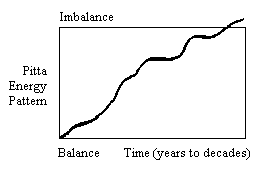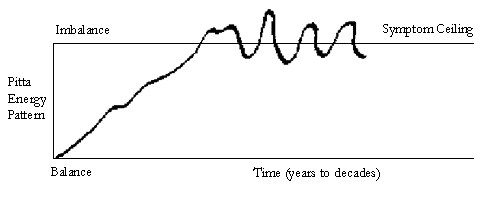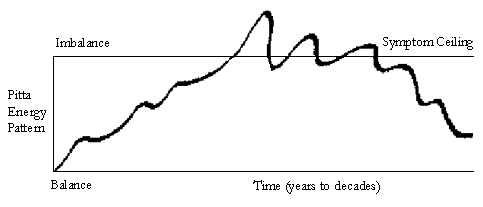Beginning to Feel Better
How long should it take?
In general, when no other conditions coexist, one can expect to begin to see changes in four to six weeks in 50 to 60% of people doing the diet. It may take longer based on the length of time of symptoms. One can say however that the longer on the diet the more one will see diminishment of symptoms. The caveat is the longer and more severe the imbalance the longer it will take. The key to the whole approach is consistency, discipline and compliance with the diet along with aloe. Cumin, coriander and fennel tea after meals is also helpful in reducing Pitta. We have seen severe imbalance take up to thirty-two weeks to totally resolve below the threshold of obvious symptoms but there was a gradual trend to improvement all along the way.If there is no improvement doing the diet and aloe within four to six weeks then further evaluation including rechecking cultures, endoscopy, and spiral CT should be considered.
Like aloe vera, cumin, coriander, and fennel tea after meals reduces Pitta and at the same time improves the digestive enzyme system (please see how to make this under Aloe and other suggestions.)
|
Foods as Energy produce balance or imbalance, i.e., painful GERD or bladder irritation. |

|
 Once the accumulated effect of the energy pattern is overwhelming in the physiology it leads to the occurrence of symptoms. In other words, the Pitta energy pattern is so excessive in its accumulation that it begins to produce symptoms of imbalance in the physiology. A threshold is reached in the body where it can no longer stay comfortable with the excess energy pattern. These symptoms can be related to the gut in terms of hyperacidity syndrome, GERD; bladder symptoms such as interstitial cystitis, prostatitis, urinary tract stone disease, or inflammatory bowel disease such as Crohnís disease. Regardless of the system involved, the accumulated energy pattern, Pitta, manifests somewhere in the matter field. But the key to understanding this accumulated energy pattern process with respect to diet is that it TAKES TIME to produce this accumulation by the foods that we take in over years.
Once the accumulated effect of the energy pattern is overwhelming in the physiology it leads to the occurrence of symptoms. In other words, the Pitta energy pattern is so excessive in its accumulation that it begins to produce symptoms of imbalance in the physiology. A threshold is reached in the body where it can no longer stay comfortable with the excess energy pattern. These symptoms can be related to the gut in terms of hyperacidity syndrome, GERD; bladder symptoms such as interstitial cystitis, prostatitis, urinary tract stone disease, or inflammatory bowel disease such as Crohnís disease. Regardless of the system involved, the accumulated energy pattern, Pitta, manifests somewhere in the matter field. But the key to understanding this accumulated energy pattern process with respect to diet is that it TAKES TIME to produce this accumulation by the foods that we take in over years. When the manifestation of symptoms occur in the physiology, letís say in the bladder, they usually occur in waves. Life is rhythmical and so it is with its dis-ease expressions. When there is a problem in the physiology, the symptoms seem to come and go, get better then worse. In the case of interstitial cystitis, the patient usually has exacerbations of the symptom complex making them think that they have another bladder infection, yet the cultures are negative. The doctor scratches his head and sends the patient to the urologist who by exclusion makes the diagnosis of interstitial cystitis. Then many different alternatives are offered but usually no dietary recommendations are made. Symptoms seem to go away and then come back. This is the nature of all disease processes in the body.
When the manifestation of symptoms occur in the physiology, letís say in the bladder, they usually occur in waves. Life is rhythmical and so it is with its dis-ease expressions. When there is a problem in the physiology, the symptoms seem to come and go, get better then worse. In the case of interstitial cystitis, the patient usually has exacerbations of the symptom complex making them think that they have another bladder infection, yet the cultures are negative. The doctor scratches his head and sends the patient to the urologist who by exclusion makes the diagnosis of interstitial cystitis. Then many different alternatives are offered but usually no dietary recommendations are made. Symptoms seem to go away and then come back. This is the nature of all disease processes in the body. When the provoking foods are eliminated from the diet then it no longer maintains the waxing and waning of symptoms. Then the process begins making a downward movement toward balance. It is important to recognize that just because the symptoms have gone away the imbalance still exists. If provoking foods are begun again, the same symptoms will occur again but it may take a little time to break through the threshold of symptoms as above. The best strategy is to stay away from the provoking foods in the Avoid column. This keeps one out of symptoms but more importantly over time will create balance in the physiology. Until we begin to feel balance, we never know how bad we really did feel.
When the provoking foods are eliminated from the diet then it no longer maintains the waxing and waning of symptoms. Then the process begins making a downward movement toward balance. It is important to recognize that just because the symptoms have gone away the imbalance still exists. If provoking foods are begun again, the same symptoms will occur again but it may take a little time to break through the threshold of symptoms as above. The best strategy is to stay away from the provoking foods in the Avoid column. This keeps one out of symptoms but more importantly over time will create balance in the physiology. Until we begin to feel balance, we never know how bad we really did feel.A synonym for balance is optimal health. Many of us walk through life hoping against hope that we will not develop symptoms of imbalance that will take us to the doctor. But as you can see from the above if we are floating between the lines of balance and imbalance then we do not experience optimal health. We are experiencing varying levels of imbalance which does not produce symptoms but does not allow us to feel optimally our best. The Ayurvedic guidelines to help create a life of balance and therefore optimal health can be found in the Resource section of this website.